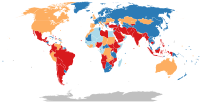
Photo from wikipedia
The rapid deployment of emergency remote teaching in the pandemic presents sweeping societal‐level information systems phenomena worthy of scholarly inquiry. This paper reports findings from teacher interviews conducted with K‐12… Click to show full abstract
The rapid deployment of emergency remote teaching in the pandemic presents sweeping societal‐level information systems phenomena worthy of scholarly inquiry. This paper reports findings from teacher interviews conducted with K‐12 public school teachers, exploring how digital access and use gaps in communities reflect wider digital and social inequalities as schools fulfilled emergency remote teaching mandates, becoming swept up into e‐learning technology expansion trends propelled by mandates, and unfettered corporate edtech. Results show persistence of home and school level digital affordance gaps as hindrances to pandemic pedagogy. We build upon theory of the digital divide, and crisis and critical informatics literature considering how critical approaches to the study of socio‐technical systems research can inform these understandings, providing insights into how localized digital inequities contribute to broader digital inequality and social inequality, in the educative processes expected of public education in democratic societies. Our work gives voice to one highly pressured and conflicted stakeholder in these dynamics—K‐12 public school teachers—and demonstrates some of the ways in which digital inequity gaps may play a further magnifying role of societal division through expanding edtech deployment in K‐12 grades, if current edtech trends hold.
Journal Title: Journal of the Association for Information Science and Technology
Year Published: 2022
Link to full text (if available)
Share on Social Media: Sign Up to like & get
recommendations!